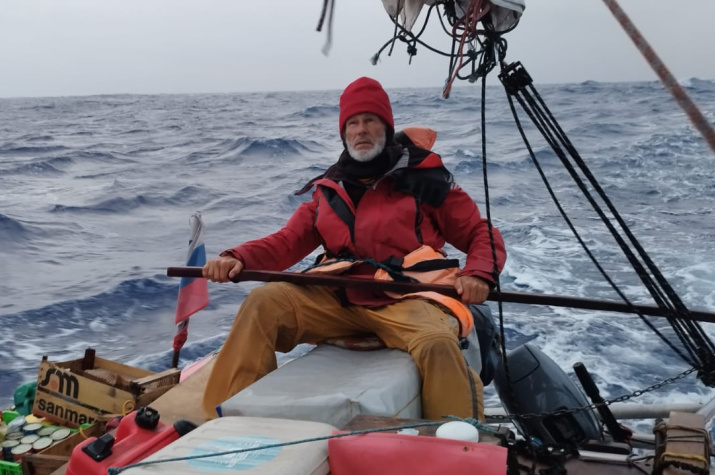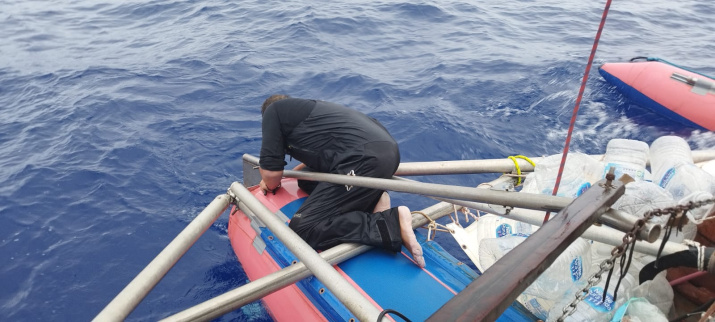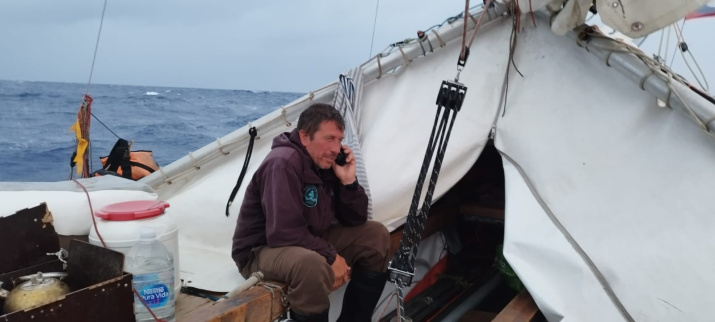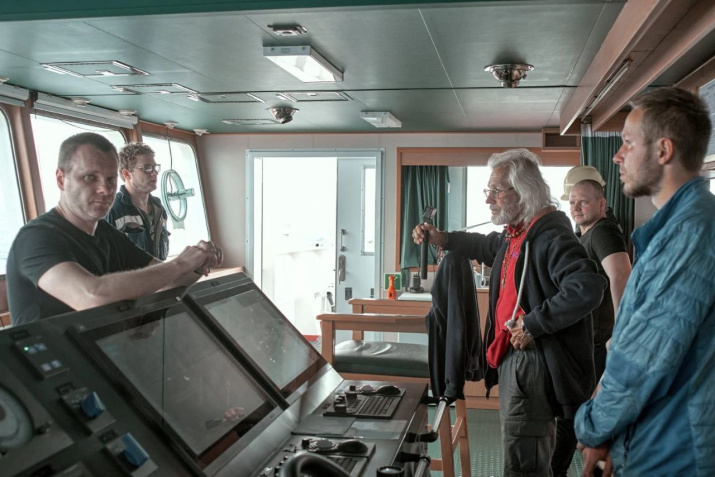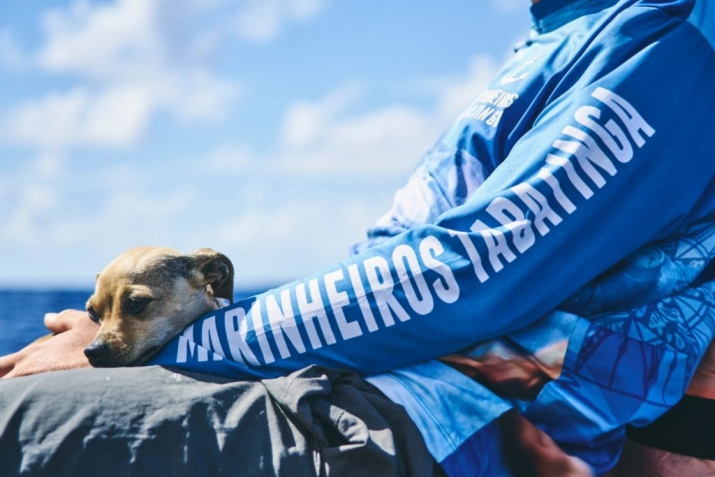The Pacific Ocean does not always live up to its name. Sometimes it becomes harsh and cruel, fully demonstrating the stormy temper of the primordial element. The first attempt to cross the boundless waters between the west of America and the east of Eurasia ended in failure for the circumnavigation expedition of the Tomsk Regional Branch of the Russian Geographical Society. In a critical situation and severe weather conditions, the crew was forced to abandon the trimaran and leave their vessel to drift at the will of the raging waves. What happened on that terrible night of March 16 and how will the circumnavigation continue? The sailors themselves will tell about this.
The first week of the voyage from the coast of South America to Easter Island was going well. The trimaran covered 300 miles to the Juan Fernandez Islands in less than three days. Strong wind was blowing for two more days , after that the sea was calm.
"From the mainland, we were told that two cyclones were moving in from the south. My wife, Lena, helps us with forecasts almost all the time when there is no cell service. The cyclones brought strong westerly winds, which pushed us to the northeast. For two days we waited, drifting in the opposite direction from the one we needed. Then the wind dropped, which allowed us to move north, away from bad weather, using the motor. But after another 200 miles, bad weather still overtook us," said Stanislav Berezkin, the captain of the trimaran.
After two days of almost dead calm, a north-westerly wind started blowing, which turned into a storm a day later. For 12 hours they had to resist gusts that reached speeds of 20 m/s and three-meter erratic waves.
According to the head of the expedition Evgeny Kovalevsky, already on March 15, after a long struggle with the elements, it became difficult to adjust the rudder and sails. After midnight, it was already clear that the steering was seriously damaged.
"It had gotten broken on my watch, and now it's broken completely. Not even broken, but torn to shreds. The ocean is harsh and wild. It's a nasty business, but familiar. Night, darkness. We turn on headlamps. We take out the tools: we need to remove the steering device together with the rudder blade. Stas undresses to a vest and thin trousers, because he has to climb the stern, find and unscrew bolts and nuts, pull out a very difficult steering box. Egor and I are handing over the tools. We change the steering device and the rudder blade. It's difficult, dangerous, takes time, but doable. By 4 in the morning, everything seems to be finished," says Evgeny Kovalevsky.
The inspection showed that the breakdown is extremely unpleasant: the transom (stern post), on which the steering device is fixed, is damaged. A crack has formed in one of the steel "ears".
"What happened was a shock for us. The trimaran, repaired in Buenos Aires, has covered 4,000 miles of rather challenging sea by this time. The east coast of South America, the Lemaire Channel, the Beagle Channel, the Strait of Magellan – these places are very difficult to navigate. The wind was strong and the waves big. And, except for the tiller extension lost in the Rio Grande (a completely insignificant part), there were no breakdowns at all. Up to this point," Berezkin noted.
This is a serious matter. The consequences of ill-considered steps are difficult to predict. It was decided to warn the coastal headquarters about the problem.
"I'm calling Yulia Kalyuzhnaya at the coastal headquarters by satellite phone. She's on Easter Island right now. We inform her about a possible trouble. We ask her to find the Chilean rescue service on the island so that if something happens, Yulia could promptly report a critical breakdown," explains Kovalevsky.
In the morning, the steering device begins to bend, and the crack grows. If the control is lost, the vessel can be carried to the south, into a zone of serious storms. The crew has water and food left for two weeks. But what would happen after that ? Stanislav checks the transom again, and then the steel "ear" of the attachment falls off. There is no more control of the trimaran.
The head of the coastal staff of the expedition, Yulia Kalyuzhnaya, went to Easter Island in advance to prepare for the meeting of the crew. She also was also prepared to take action in case of an emergency.
"That's why, when the call came on March 16, I acted according to the established plan. I contacted the ‘Marine Community’, its member Julio, and gave him the coordinates. I had an understanding that these people would do everything right, quickly and professionally. In addition, on Easter Island, the owner of the hotel, a former naval officer, heard my conversation and asked what had happened. I explained it to him. He said, ‘Get in the car, let's go to the Chilean navy.’ There the SOS signal was shown on the big screen. Together we looked at which ships were in the vicinity of the trimaran. As a result, it became clear that in about four hours a cargo ship under the Panamanian flag should approach. We agreed with the crew that they would transmit their coordinates every hour," Kalyuzhnaya said.
During the day, the crew's satellite phone received several calls from rescuers. They were incredibly lucky that one of the crew members, Egor Muzileyev, speaks excellent Spanish. He was negotiating.
"Rescuers find several vessels performing different tasks in the wreck area. We report the coordinates. The closest is the Panamanian bulk carrier ‘Sounion’", said Kovalevsky.
The crew understands that, perhaps, the trimaran will have to be abandoned in the ocean. The team packs documents, filming equipment, personal belongings. A lot will have to be left on board, in difficult conditions you just can't take everything with you.
"Fortunately for us, the sea is completely calm, but it's raining, visibility is poor, high swell. At about 21:30 we saw the lights of the bulk carrier. But for some reason I didn't feel much joy. Yes, everything was resolved successfully, but, unfortunately, everything was over. Yes, the captain agreed to take our trimaran in tow, but will it reach the shore in tow?" Berezkin noted.
The rescue operation lasts about three hours. Not everything goes smoothly, the waves are serious. The cargo ship of the “Laskaridis Maritime” company is standing on the leeward side, the trimaran is slowly being pushed towards the ship.
"It's awful, the steel wall of the ship, eight meters high, hanging over our tiny 'inflatable'. The trimaran keeps continuously hitting the side and being pulled under the steel hull of the 'Sounion'. It's scary," admits Kovalevsky.
The crew of the ocean vessel unsuccessfully tries to lower a boat overboard to receive the travelers and their belongings. The boat hangs in the air with people and beats against the side. The captain cancels the descent and gives the command to throw down two pulling ropes that get attached to the trimaran. With the risk of falling overboard, evacuation begins. Egor and Pasoka are the first to leave, then Evgeny, and Stas is last.
"I grabbed the ladder, but the arm I had dislocated a week earlier let go and I flew into the water. I didn't feel any fear, I just saw that I was caught between the side and the three-ton trimaran flying at me. Thoughts that this was the end of all my adventures were interrupted by a sharp jerk of the safety line. I flew over the trimaran and landed on the left hull. 'Not now,' I grinned and prepared to grab the ladder with my right, healthy hand. On the second attempt, the ladder flew past, I pushed off with my hand from the side and stood on my feet. After a couple of seconds, concentrating, I finally caught it and climbed up with the last of my strength. A second later, a meter from my feet, the trimaran rattled a beam against the side, but I was already climbing over the rail onto the deck. I moved almost crawling, my hands and feet were shaking. 'I would like some water…' I croaked to the Filipino sailor in Russian," Berezkin said.
The ship's captain agreed to tow the expedition's trimaran. Everything went well at first. The "Sounion" is moving to the Strait of Magellan, going from the USA to Brazil, the trimaran is visible astern. The circumnavigators are allocated personal cabins.
However, soon the captain reports that the trimaran was torn off from the bulk carrier. The Pacific Ocean does not want to give up its prey.
The shipowner allowed another attempt at towing. The trimaran is visible on the radar, an hour later it is already nearby. Berezkin was supposed to jump on board the inflatable vessel to tie it again. But the weather has changed, the waves and the wind have increased, which is why the captain does not allow the operation. It's too life-threatening.
The crew is trying to hook the trimaran with a weighted rope and pull it closer to the bulk carrier. If it doesn't work out, the operation ends – the "Sounion" is already behind the schedule by 12 hours.
“The first mate swings and throws the rope on the trimaran. The end didn't catch. The trimaran is slowly moving away along the side. Fortunately, the board is long. There are chances. The first mate throws again – failure. The Filipino sailors throw two more times – failure. The trimaran is out of reach," Kovalevsky describes the situation.
According to Egor Muzileyev, the crew was grieving the loss of their vessel, which had become their home. Everyone was constantly wondering what had been done wrong. In addition, many personal and expedition items remained on board.
"The only thing that I personally could not afford to lose in this situation was Pasoka. Fortunately, the dog is with us, alive and well. Even though a lot of electronics and equipment have sunk, they can be bought later," Muzileyev added.
Egor plans to take a break from his travels and return with Pasoka to his mother, whom he has not seen in about two years. It's her birthday soon.
"It is not yet known where the new roads will lead us. It is possible that we will once again become part of the expedition, from which, despite everything, we have very good memories," Muzileyev said.
The head of the coastal headquarters, Yulia Kalyuzhnaya, admitted that she cried with the crew when the loss of the trimaran had become known.
"At night, there was another call from the satellite phone. Evgeny Aleksandrovich with a sore throat reported that the trimaran had been torn off. The crew saw it leaving for the Pacific Ocean, but there was nothing they could do about it. I cried with them, because we put so much effort into ensuring that the expedition could continue. I personally laid out food for them, unloaded things, arranged sleeping places. I had my own special love for this vessel. For me it was a small house on the water. Therefore, such a pain of loss, of course, is not commensurate with anything," Kalyuzhnaya stressed.
On March 25, the cargo ship with the circumnavigators on board arrived safely in the Chilean Punta Arenas. The Russians stepped ashore and received a very warm welcome from local authorities, old acquaintances, and journalists.
The members of the expedition did not lose heart and did not abandon their plans. There is an option to continue sailing. Eight years ago, the Russian traveler Dmitry Trubitsin took an inflatable catamaran from Peru to Easter Island, where he left his vessel until better times.
After Yulia Kalyuzhnaya said that the circumnavigation could be continued, Kovalevsky and Berezkin contacted Dmitry Trubitsin. He gave permission to use his catamaran. Already in April of this year, the expedition "Following the paths of Russian explorers " expects to repeat the attempt to cross the Pacific Ocean.
On July 1, 2021, Siberian travelers Evgeny Kovalevsky and Stanislav Berezkin set off along the route of the first Russian round-the-world expeditions of the 19th century: Ivan Kruzenshtern’s (1803-1806), Yuri Lisyansky’s (1803-1806), Otto Kotzebue’s (1815-1818, 1823-1826), Vasily Golovnin’s (1817-1819), Fedor Litke’s (1826-1829), Faddey Bellingshausen and Mikhail Lazarev’s (1819-1921). The international project of the Tomsk Regional Branch of the Russian Geographical Society "Following the paths of Russian explorers" is dedicated to the 250th birthday anniversary of Krusenstern and the 200th anniversary of the discovery of Antarctica by Russian sailors. These events for a long time determined Russia's leadership in the development of the oceans and the discovery of new lands. You can learn more about the project and provide all possible assistance in its implementation on the website of the expedition.
Alexander Zhirnov

